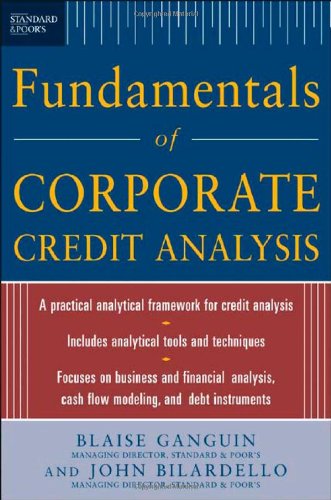Standard & Poor's Fundamentals of Corporate Credit Analysis pdf
Par west kristi le dimanche, juin 18 2017, 09:42 - Lien permanent
Standard & Poor's Fundamentals of Corporate Credit Analysis. Blaise, Ganguin

Standard.Poor.s.Fundamentals.of.Corporate.Credit.Analysis.pdf
ISBN: 0071454586, | 463 pages | 12 Mb

Standard & Poor's Fundamentals of Corporate Credit Analysis Blaise, Ganguin
Publisher: McGraw-Hill
(NYSE:CHK) fell as much as 6 percent after S&P downgraded its credit rating of the company to "BB-" from "BB," reflecting shortcomings in Chesapeake's corporate governance practices and covenant concerns. At this rate we expect annual corporate cash flow growth to hit zero and turn negative in a few short months. The cut to the two state-run companies is in line with S&P's cut to Brazil's sovereign credit rating. In the press release, S&P credit analyst Robert Schulz said: "The upgrade reflects our view that, among other things, Ford's prospects for generating free cash flow and profits in its automotive manufacturing business remain intact, because of its cost base in North America." . Managing enterprise-wide risks and capitalizing on opportunities are fundamental responsibilities of senior executives at all firms. Perhaps because I'm not an economist, I can't at all interest myself in the question of whether the US “deserved” to have its credit rating downgraded (as Standard and Poor's has done). Integration into Credit Ratings Related Materials. Standard & Poor's today raised the corporate credit rating on Ford and Ford Motor Credit to BB+ from BB–. Standard & Poor's Fundamentals of Corporate Credit Analysis. Its negotiation, one of the fundamentals of free enterprise. Standard and Poor's forecasts modest growth for the rest of 2013, stating that “weaker fiscal and external fundamentals, and some loss in the credibility of economic policy given ambiguous policy signals could diminish Brazil's ability to Eletrobras is Brazil's electrical utility company and Petrobras is a multinational energy corporation headquartered in Rio de Janeiro. And only point us towards a simpler way of addressing the problem: Standard and Poor's is a self-interested corporate entity and it is acting in accordance with what it perceives its self-interest to be, in precisely the way that self-interested corporate entities will consistently do. Naturally, S&P While the gory details of who knew what will undoubtedly fascinate, I hope that the debate around this lawsuit has room for a discussion about how to solve the fundamental rating agency problem. Dreyer and Amra Balic, “Progress Report: Integrating Enterprise Risk Management Analysis into Corporate Credit Ratings,” Standard & Poor's RatingsDirect, July 22, 2009. Another POMO, another dip bought, another all-time high in the S&P 500 but we are sure there is some disappointment that the '1600' caps have to go back in the closet for one more day. While cancelling this upgrade allowed S&P to remain competitive with Moody's and Fitch, it (allegedly) did a huge disservice to AAA investors such as the Western Federal Credit Union, on whose behalf the government filed its complaint.